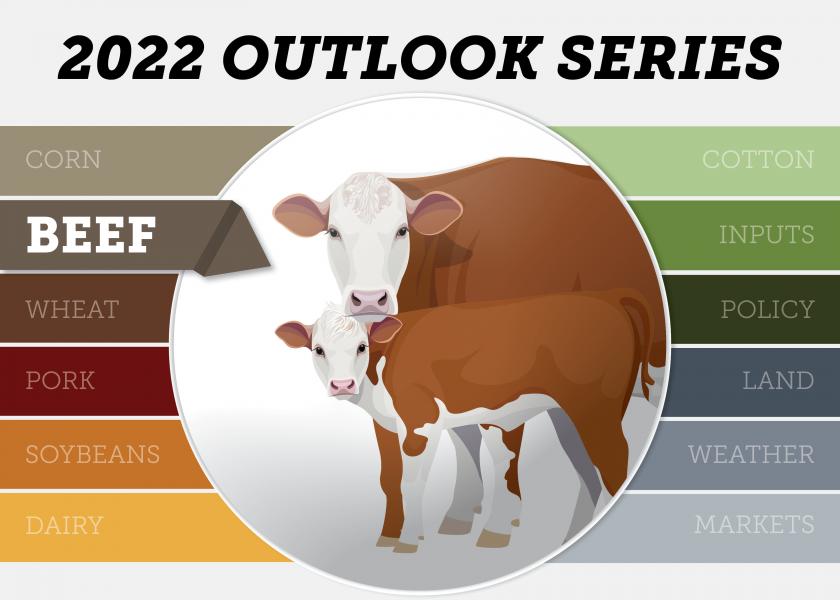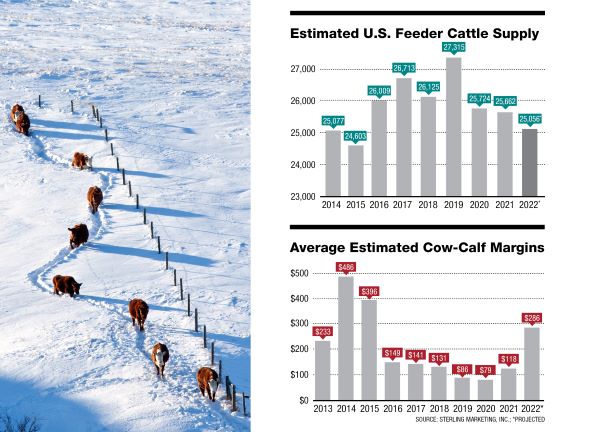Cattle Outlook Optimistic for 2022

Optimism is building in cattle country that 2022 will finally deliver a long-anticipated bull market for cattle. Ranchers and cattle feeders saw markets turn higher in the final weeks of 2021, and while many of the challenges facing the industry last year will continue, most analysts suggest improving prices are a trend that will continue beyond this year.
“Demand for beef, both domestically and in our exports markets, was strong throughout 2021 and will continue,” says John Nalivka, Sterling Marketing, Vale, Ore. “With declining cattle numbers, we’re seeing things fall into place for better cattle markets the next couple of years.”
Market-ready supplies of fed cattle have tightened and packers are actively chasing cattle for the first time in many months. In general, cattle prices are higher now compared to a year ago and are expected to continue improving in 2022.

Such sentiment is shared by industry analysts across the country who see robust demand continuing as the industry has worked through many of the pandemic-related challenges. CattleFax CEO Randy Blach said the cattle cycle should have seen a peak in 2020, but it was pushed back by pandemic-related slaughter bottlenecks.
“This has been a long, hard-fought battle,” Blach said. “Retail beef prices have gone up substantially and demand has been out of this world. Cattle prices just haven’t shared in that move up until now.”
Demand has been very strong for all proteins, including pork and poultry, he said.
“All the proteins have benefitted from this demand push that we’ve experienced.”
Demand may be good, but tightening supplies are the primary factor influencing analyst’s optimism.
“Cattle numbers are declining as low prices and drought have both led to herd liquidation over the past two years,” Nalivka says.
In fact, U.S. beef cow slaughter was 10% higher in 2021, and that followed a 3% increase from 2020.
“We saw the highest beef cow slaughter last year since the drought year of 2011,” Nalivka says. “From 2011 to 2013 the drought, beginning in the Southwest and moving to the Midwest, pushed the beef cow herd numbers in 2014 to its lowest point since 1952.”
With dairy cow slaughter up roughly 3% in 2021, total cow slaughter posted a 6% increase and the highest since 1996. With those slaughter numbers, Sterling Marketing projects the 2022 beef cow inventory to be 30.2 million, a reduction of roughly 1 million cows, or 3%.
Additionally, heifer slaughter in 2021 was the highest since 2011. Nalivka projects 2022 heifer slaughter to be 4% lower than 2021 and just marginally higher than during 2012.
“The higher beef cow and heifer slaughter numbers that we saw in 2021 mean reduced cattle numbers for 2022 and likely through 2024 are evident,” Nalivka says. My forecast for the January 1 total cattle inventory is 91.25 million, down 2% from the beginning of 2021, the lowest since 2015, and 475,000 more than the beginning 2012 cattle herd.”
A reduction of the breeding herd will translate into a reduction in cattle slaughter. Nalivka expects total slaughter to be down 2% in 2022 after the 3% increase found in 2021.
“I also expect carcass weights to decline this year as fed cattle numbers decline and feedlots are increasingly current with showlists and marketing cattle into a stronger market,” Nalivka said. “Assuming a 1% year-over-year drop in carcass weights, beef production in 2022 will be down 3%.”
Overall, Nalivka projects the total red meat and poultry supply, per capita, to decline about 0.5% to 220.7 pounds in 2022.
“Even if demand weakens somewhat, prices across the beef complex – including fed cattle, feeders and calves – will post notable gains during 2022,” Nalivka says. “That is further supported by global beef demand.”
In fact, beef export values soared last year and were expected to exceed $10 billion, according to USDA.
Beef exports reached 115,709 metric tons in October, up 7.5% from a year ago, while export value climbed 48% to $956.9 million – the second-highest total on record, behind August 2021. Through the first 10 months of the year, beef exports totaled 1.19 million metric tons, up 17% from a year ago. Export value increased 38% to $8.53 billion, surpassing the 2018 record ($8.33 billion) with two months to spare.
U.S. Meat Export Federation president and CEO Dan Halstrom acknowledged red meat exports face transportation challenges and rising input costs, yet he expected red meat exports would reach about $18 billion in 2021.
“While global demand is tremendous and we are cautiously optimistic about further growth in 2022, supply chain pressures are not easy to overcome and are a growing concern for exporters and their international customers,” Halstrom said.







